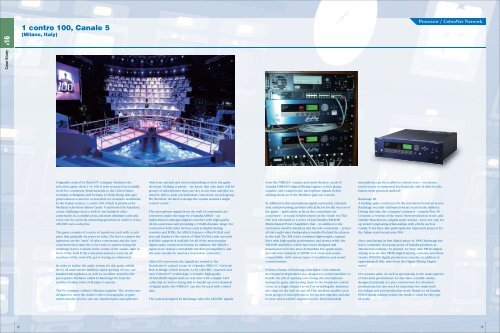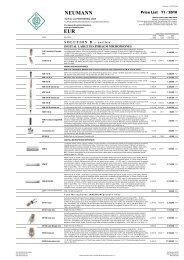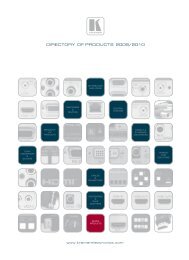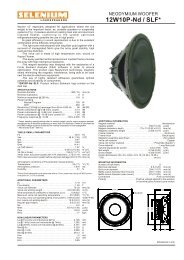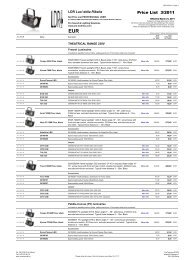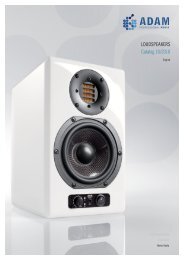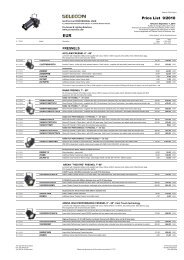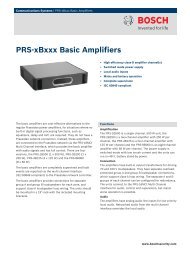Download - Yamaha Downloads
Download - Yamaha Downloads
Download - Yamaha Downloads
You also want an ePaper? Increase the reach of your titles
YUMPU automatically turns print PDFs into web optimized ePapers that Google loves.
Case Study #16<br />
1 contro 100, Canale 5<br />
(Milano, Italy)<br />
Originally created by Dutch TV company Endemol, the<br />
television game show 1 vs. 100 is now screened successfully<br />
in all five continents. From Australia to the United States,<br />
Germany to Bulgaria, and Vietnam to Honk Hong, this quiz<br />
phenomenon is aired in no less than 22 countries worldwide.<br />
In the Italian version, 1 contro 100, which is produced by<br />
Mediaset television station Canale 5 and hosted by Amadeus,<br />
a lone challenger faces a wall of one hundred other<br />
contestants in a combat arena and must eliminate each and<br />
every one by correctly answering questions in order to win a<br />
200,000 euro cash prize.<br />
The game consists of a series of questions, each with a cash<br />
prize that gradually increases in value. The first to answer the<br />
questions are the "mob" of other contestants, and the lone<br />
contestant then takes his or her turn to answer, facing the<br />
challenge from a rostrum in the centre of the studio, right in<br />
front of the wall. If the contestant answers correctly, all<br />
members of the mob who got it wrong are eliminated.<br />
In order to realize the audio system for this game, which<br />
above all must ensure faultless, rapid opening of over one<br />
hundred microphones, as well as excellent sound for the<br />
participants, Mediaset called in Backstage PA from the<br />
northern Italian town of Mariano Comense.<br />
The PA company’s Alberto Mariani explains, “The system was<br />
designed to meet the studio’s strict scenographic requirements<br />
and the need to use one hundred plus microphones,<br />
which are opened and closed depending on how the game<br />
develops. Nothing is preset – we know that only there will be<br />
groups of microphones that can vary at any time and that we<br />
must be able to pick out individual contestants in each group.<br />
We therefore decided to design the system around a single<br />
control centre.”<br />
The microphone signals from the wall of contestants are<br />
converted under the stage by a <strong>Yamaha</strong> AD824 – an<br />
eight-channel analogue/digital converter with high-quality<br />
24-bit conversion and providing a 110-dB dynamic range. For<br />
connection with other devices such as digital mixing<br />
consoles and MTRs, the AD824 features a Mini-YGDAI card<br />
slot, and thanks to the variety of Mini-YGDAI cards currently<br />
available, support is available for all of the most-popular<br />
digital audio connection formats. In addition, the AD824’s<br />
inputs have remote-controllable mic/line preamplifiers, and<br />
the unit can also be used as a stand-alone converter.<br />
After A/D conversion, the signals are routed to the<br />
broadcaster’s control room via a <strong>Yamaha</strong> NHB32-C Network<br />
Hub & Bridge, which features 32 I/O AES/EBU channels and<br />
uses CobraNet technology to transfer high-quality<br />
24-bit/48-kHz digital audio in real time with a simple Cat5<br />
cable link. As well as being able to handle up to 64 channels<br />
of digital audio, the NHB32-C can also be used with control<br />
data.<br />
The system designed by Backstage takes the AES/EBU signals<br />
from the NHB32-C outputs and sends them to a pair of<br />
<strong>Yamaha</strong> DME64N Digital Mixing Engines, which group,<br />
equalize, and compress the microphone signals, before<br />
sending them on to the Mediaset play-out console.<br />
In addition to this microphone-signal conversion, transmission,<br />
and processing, another critical factor for the success of<br />
the game – particularly as far as the contestants are<br />
concerned – is sound reinforcement on the studio set. This<br />
role was entrusted to a series of four <strong>Yamaha</strong> XM4180<br />
Multi-channel Power Amplifiers that – in addition to the<br />
enclosures used by Amadeus and the solo contestant – power<br />
all sixty-eight mini loudspeakers installed behind the players<br />
in the wall. The XM series combines lightweight, compact<br />
lines with high-quality performance and power, while the<br />
XM4180 amplifiers, which have been designed and<br />
manufactured for the most demanding live applications,<br />
provide four channels of 180 W on 8 ohms and ensure<br />
compatibility with various types of installation and sound<br />
control system.<br />
Federico Farina of Backstage concludes, “Our software<br />
development department also designed a control interface to<br />
handle the job of opening and closing the microphones<br />
during the game and sending them to the broadcast control<br />
room on a single channel, as well as switching the luminous<br />
mic rings on the wall on and off. This interface enables us to<br />
form groups of microphones to be opened together, and also<br />
to store and recall the required scenes. Each individual<br />
microphone can be recalled in various ways – via mouse,<br />
touch screen or numerical keyboard, the last of which is the<br />
fastest, most practical method.”<br />
Backstage PA<br />
A leading audio contractor for the television broadcast sector,<br />
Backstage recently celebrated twenty years in the industry.<br />
During this time, the company's partners – namely, Pino Di<br />
Costanzo, a veteran of the music show-production scene, and<br />
Daniele Mascheroni, a digital audio wizard – have not only set<br />
up steady long-lasting relationships with clients such as<br />
Canale 5, but have also participated in important projects for<br />
the Italian state broadcaster, RAI.<br />
Since purchasing its first digital mixer in 1990, Backstage has<br />
had a constantly increasing stock of <strong>Yamaha</strong> products, as<br />
Mascheroni explains: “At present, we have nine PM1D digital<br />
mixing systems, five PM5D digital mixing consoles, and about<br />
twenty DM2000 digital production consoles, in addition to<br />
approximately fifty units from the Digital Mixing Engine<br />
series.”<br />
Di Costanzo adds, “As well as specializing in the audio aspects<br />
of television productions, we also have a mobile studio,<br />
designed primarily as a pre-control room for television<br />
productions, but also used for important live multi-track<br />
recordings and post-production work. Thanks to its <strong>Yamaha</strong><br />
PM1D digital mixing system, the studio is ideal for this type<br />
of work.”<br />
Processor / CobraNet Network<br />
29 30


